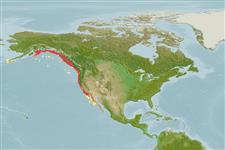Common names from other countries
>
Perciformes/Scorpaenoidei (Scorpionfishes) >
Sebastidae (Rockfishes, rockcods and thornyheads) > Sebastinae
Etymology: Sebastes: Greek, sebastes = august, venerable (Ref. 45335); diploproa: From the Greek diploos and prora, meaning 'double' and 'prow' (Ref. 27436).
More on author: Gilbert.
Environment: milieu / climate zone / depth range / distribution range
Écologie
marin bathydémersal; profondeur 0 - 800 m (Ref. 6793), usually 91 - 579 m (Ref. 2850). Deep-water; 60°N - 27°N, 168°W - 109°W
Northeast Pacific: Alaska Peninsula to Cedros Island, Baja California and the Gulf of California in Mexico.
Length at first maturity / Taille / Poids / Âge
Maturity: Lm 19.0, range 18 - ? cm
Max length : 46.0 cm TL mâle / non sexé; (Ref. 4925); poids max. publié: 810.00 g (Ref. 40637); âge max. reporté: 86 années (Ref. 56049)
Épines dorsales (Total): 13; Rayons mous dorsaux (Total): 11-14; Épines anales 3; Rayons mous anaux: 5 - 8; Vertèbres: 26. Head spines strong - nasal, preocular, postocular, tympanic and parietal spines present, supraocular, coronal and nuchal spines absent (Ref. 27437). Toothed knob in front of each upper jaw, deep notch between jaws (Ref. 27437). Caudal fin moderately indented (Ref. 6885). A red rockfish, silver ventrally (Ref. 27437). Branchiostegal rays: 7 (Ref. 36715).
Common offshore, on soft bottoms (Ref. 2850). Young occur in shallow water, often at surface under drifting kelp (Ref. 2850). Viviparous, with planktonic larvae and pelagic juveniles (Ref. 36715, 34817). The biggest individuals are sometimes found in markets where the flesh is sold as rockfish fillet (Ref. 27436). Rarely caught by anglers (Ref. 27436).)
Gives birth in spring (Ref. 27436).
Eschmeyer, W.N., E.S. Herald and H. Hammann, 1983. A field guide to Pacific coast fishes of North America. Boston (MA, USA): Houghton Mifflin Company. xii+336 p. (Ref. 2850)
Statut dans la liste rouge de l'IUCN (Ref. 130435)
CITES (Ref. 128078)
Not Evaluated
Menace pour l'homme
Harmless
Utilisations par l'homme
Pêcheries: intérêt commercial mineur
Plus d'informations
RéférencesAquacultureProfil d'aquacultureSouchesGénétiqueElectrophoresesHéritabilitéPathologiesTraitementMass conversion
CollaborateursImagesStamps, Coins Misc.SonsCiguateraVitesseType de nageSurface branchialeOtolithesCerveauxVision
Outils
Articles particuliers
Télécharger en XML
Sources Internet
Estimates based on models
Preferred temperature (Ref.
115969): 4.4 - 8.6, mean 5.9 (based on 131 cells).
Phylogenetic diversity index (Ref.
82804): PD
50 = 0.5000 [Uniqueness, from 0.5 = low to 2.0 = high].
Bayesian length-weight: a=0.01000 (0.00499 - 0.02004), b=3.09 (2.92 - 3.26), in cm Total Length, based on LWR estimates for this Genus-body shape (Ref.
93245).
Niveau trophique (Ref.
69278): 3.5 ±0.39 se; based on food items.
Résilience (Ref.
120179): Faible, temps minimum de doublement de population : 4,5 à 14 années (tm=5; tmax=86; Fec=14,000).
Fishing Vulnerability (Ref.
59153): Moderate vulnerability (36 of 100).
